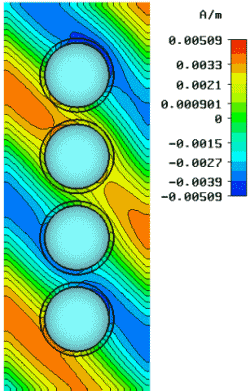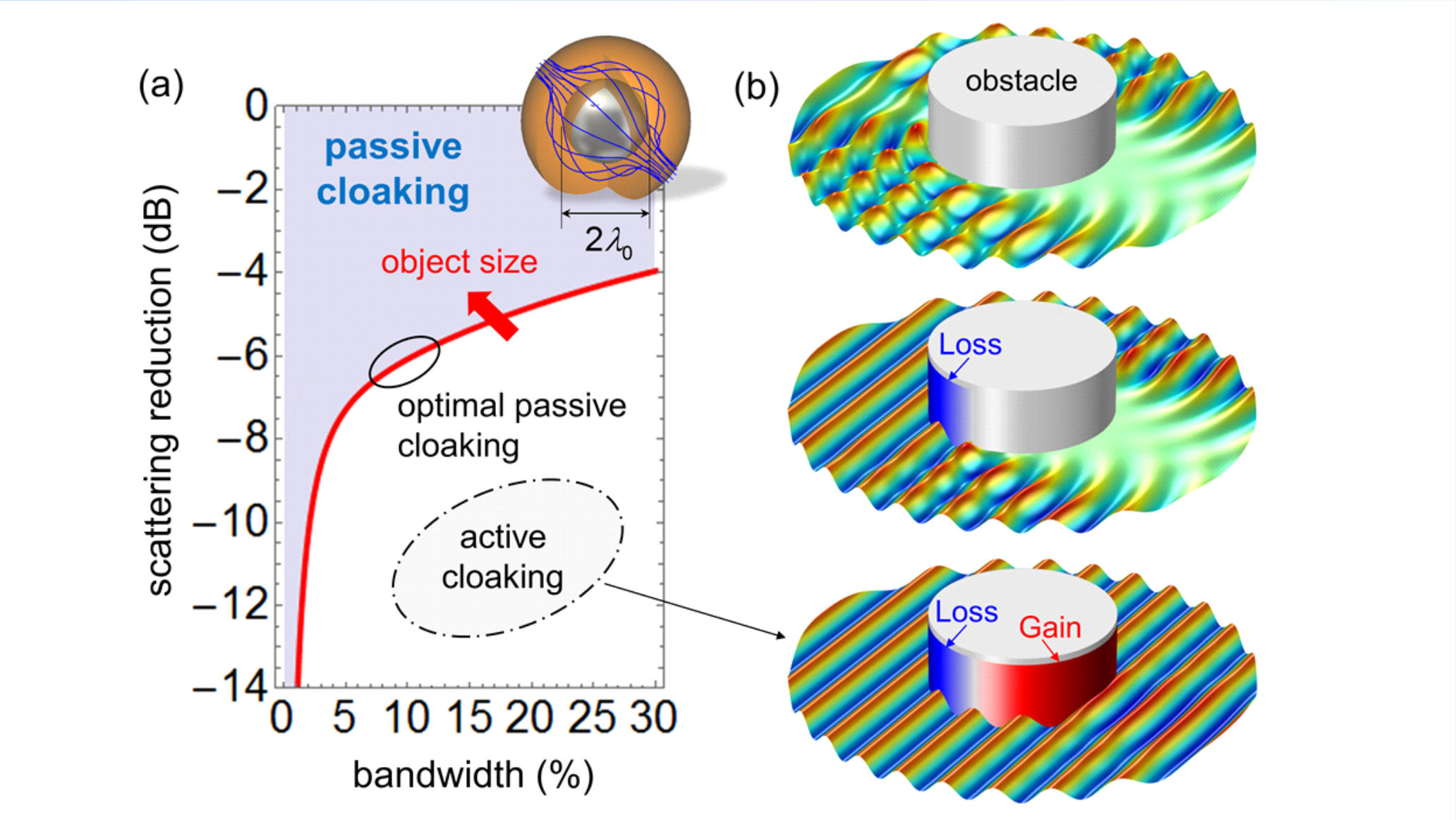Cloaking and Invisibility
 One of the most exciting applications of metamaterials consists in the possibility of suppressing the overall scattering from an arbitrary object by covering it with a suitably designed ‘cloak’. From the conceptual point of view, there are various ways to realize metamaterial cloaks, but their experimental realization and functionality is fundamentally challenging, since scattering suppression for all angles of observation often faces causality constraints. Our group has introduced two techniques to realize electromagnetic cloaks: (i) the ‘plasmonic cloaking’ technique, introduced in 2005 the concept that metamaterials may be used for scattering suppression, and the ‘mantle cloaking’ technique, introduced in 2009 as the first approach to cloaking based on a metasurface with negligible thickness. In both cases the idea is to use metamaterial or metasurafce covers to suppress the scattering of dielectric and conducting objects, based on destructive interference, or scattering cancellation, at all angles.
One of the most exciting applications of metamaterials consists in the possibility of suppressing the overall scattering from an arbitrary object by covering it with a suitably designed ‘cloak’. From the conceptual point of view, there are various ways to realize metamaterial cloaks, but their experimental realization and functionality is fundamentally challenging, since scattering suppression for all angles of observation often faces causality constraints. Our group has introduced two techniques to realize electromagnetic cloaks: (i) the ‘plasmonic cloaking’ technique, introduced in 2005 the concept that metamaterials may be used for scattering suppression, and the ‘mantle cloaking’ technique, introduced in 2009 as the first approach to cloaking based on a metasurface with negligible thickness. In both cases the idea is to use metamaterial or metasurafce covers to suppress the scattering of dielectric and conducting objects, based on destructive interference, or scattering cancellation, at all angles.
After our theoretical work on the topic, we have also shown how plasmonic and mantle cloaks may be used to realize ‘invisible sensors,’ i.e., to suppress the scattering of a receiving antenna or sensor without affecting its possibility to receive incoming signals. This concept may have exciting implications in low-invasive near-field measurements. We have also extended this concept to realistic configurations, such as radio-frequency dipoles and near-field scanning optical microscopes. Along the years we have been able to show that these cloaking techniques are inherently robust to shape and losses, may be applied to arbitrarily shaped objects and elongated cylinders, which proved essential for the recent experimental realization of these concepts.
Following a preliminary experimental verification of plasmonic cloaking inside a waveguide, in 2012 we have been able to verify the first metamaterial cloak for a 3D object in free-space, an achievement that has been highlighted in the major scientific and popular news outlets, including BBC News, and has been recently chosen to be included in IoP Select. In 2013 we also experimentally verified for the first time the mantle cloaking technique. We showed that this idea leads to more robust cloaking performance, is inherently low-profile and conformal, and it does not require realizing bulk metamaterial properties, which are often challenging to achieve.
[youtube]https://youtu.be/KrQFW2dv-ck[/youtube]
Introducing Cloaking (TACC video)
Our most recent work on this topic has shown fundamental bounds on cloaking using passive metamaterials, proving that any passive layer placed on top of an object is bound to scatter more than the object itself, when integrated over all wavelengths. We have also proposed the use of non-Foster, active metasurface technology to overcome these limits and realize broadband cloaks. In recent years, we have extended these ideas beyond electromagnetic waves, showing that scattering cancellation and invisible sensors may be realized also for acoustic and matter waves.
We have also put forward various ideas to use plasmonic cloaks to manipulate the scattering features of nanoparticles, in order to make an impact beyond camouflaging, in the realm of nanodevices, such as nanoswitches and memories, as well as for energy harvesting and biomedical sensing.
Fundamental Limitations on Passive Cloaking, and Beyond
Invisibility has been a powerful cultural theme for millennia. Relevant scientific advances in this fascinating subject have been recently enabled by the field of metamaterials, leading to proof-of-concept demonstrations of actual “invisibility cloaks”. As consistently observed in different studies, however, the ability to hide an object from sight is fundamentally challenging, especially for large objects and broadband illumination (e.g., white light or short pulses).
In our recent work, we have analyzed these challenges for arbitrary electromagnetic cloaks. By taking inspiration from analogous problems that arise in microwave systems, we have derived quantitative physical bounds for passive cloaks, stemming from general causality and passivity considerations, which reveal the optimal trade-off between object size, visibility reduction and bandwidth. These theoretical limitations hold for any passive cloaking technique aimed at making an object invisible by reducing the total light scattering, and depend only on the properties and size of the object to be concealed. Our findings confirm that broadband invisibility of human-scale objects at optical frequencies is impossible with passive cloaks of arbitrary complexity. Instead, the derived bounds quantitatively show that robust cloaking performance, of technological and industrial relevance, can be obtained for objects with size smaller or comparable to the wavelength, such as radio-frequency antennas or micro- and nano-sensors at optical frequencies.
Recently, we have also envisioned a path forward in the quest to break the derived bounds on invisibility using active systems, which may allow broadband cloaking by drawing energy from an external source. In this context, we have recently proposed an active metasurface cloak based on balanced distributions of loss and gain, forming a so-called parity-time symmetric configuration. The passive and active portions of the cloak work in concert to cancel the reflections and shadows of an object. A thin cloak of this kind allows making large objects unidirectionally invisible.
Our findings provide quantitative tools to assess the performance and applicability of cloaking technology, and suggest that active or nonlinear materials and systems may open exciting directions in the century-long quest for invisibility.

(a) Fundamental trade-off (red line) between how much an object can be made invisible (scattering reduction; vertical axis) and the bandwidth (horizontal axis) over which this effect can be achieved [1]. Here we consider an impenetrable sphere with a diameter twice the central wavelength. The trade-off becomes stricter for bigger objects: the red arrow in the figure indicates how the bound changes as the object gets bigger compared to the wavelength. (b) Unidirectional invisibility based on active cloaking [4]. From top to bottom: wave impinging on an impenetrable obstacle; lossy metasurface cloak to suppress reflections; active metasurface cloak with balanced loss/gain distribution. The temporal evolution of the active cloak is shown in the accompanying video.
To learn more:
Andrea Alù at TEDx Austin, “On the Quest to Invisibility: Metamaterials and Cloaking”, February 19, 2013. (TED website) – Text available here.
S. Cunningham, “Introducing Cloaking,” Youtube, Texas Advanced Computing Center, April 24, 2012.
J. Hanson, “The Invisible Man,” The Alcade, March 1, 2014.T. Wogan, “Heat Cloaks Hide Objects in 3D,” Physics World, February 7, 2014.
T. Wogan, “Heat Cloaks Hide Objects in 3D,” Physics World, February 7, 2014.
E. Schechter, “How Far Away Are Active Invisibility Cloaks?,” Popular Mechanics, February 7, 2014.
F. Monticone, and A. Alù, “Invisibility Exposed: Physical Bounds on Passive Cloaking,” Optica, Vol. 3, No. 7, pp. 718-724, July 5, 2016. (web) [UT Austin press release]
F. Monticone, and A. Alù, “Do Cloaked Objects Really Scatter Less?,” Physical Review X, Special Issue on Metamaterials, Vol. 3, No. 4, 041005 (10 pages), October 21, 2013, (invited paper). (web, arxiv) [Press coverage by BBC, NBC News and Physics World]
D. L. Sounas, R. Fleury, and A. Alù, “Unidirectional Cloaking Based on Metasurfaces with Balanced Loss and Gain,” Physical Review Applied, Vol. 4, 014005 (11 pages), July 16, 2015. (web)
R. Fleury, and A. Alù, “Furtive Quantum Sensing Using Matter-Wave Cloaks,” Physical Review B, Rapid Communication, Vol. 87, No. 20, 201106(R) (5 pages), May 15, 2013. (web, arxiv)
J. C. Soric, P. Y. Chen, A. Kerkhoff, D. Rainwater, K. Melin, and A. Alù, “Demonstration of an Ultralow Profile Cloak for Scattering Suppression of a Finite-Length Rod in Free Space,” New Journal of Physics, Vol. 15, No. 3, 033037 (18 pages), March 25, 2013. (web) [Highlighted by many news outlets, including CNN, NBC, Fox, Discovery, US News, Daily Mail]
R. Fleury, and A. Alù, “Plasmonic Cloaking of Matter Waves,” Physical Review B, Vol. 87, No. 4, 045423 (6 pages), January 22, 2013. (web)
F. Monticone, C. Argyropoulos, and A. Alù, “Cloaking Plasmonic Layers to Tailor the Optical Scattering at the Nnanoscale,” Scientific Reports, Special Issue for E-MRS 2012, Vol. 2, No. 912, December 3, 2012, (invited paper). (web)
P. Y. Chen, J. Soric, and A. Alù, “Invisibility and Cloaking Based on Scattering Cancellation,” Advanced Materials, Vol. 24, No. 4, pp. OP281-OP304, November 20, 2012, (invited review paper). [An image from this article was selected for the front cover] (web)
M. D. Guild, M. R. Haberman, A. Alù, “Plasmonic-Type Acoustic Cloak Made of a Bilaminate Shell,” Physical Review B, Vol. 86, No. 10, 104302 (13 pages), September 7, 2012. (web)
Y. R. Padooru, A. B. Yakovlev, P. Y. Chen, and A. Alù, “Analytical Modeling of Conformal Mantle Cloaks for Cylindrical Objects Using Sub-Wavelength Printed and Slotted Arrays,” Journal of Applied Physics, Vol. 112, No. 3, 034907 (13 pages), August 14, 2012. (web)
D. Rainwater, A. Kerkhoff, K. Melin, J. C. Soric, G. Moreno, and A. Alù, “Experimental Verification of Three-Dimensional Plasmonic Cloaking in Free-Space,” New Journal of Physics, Vol. 14, 013054 (13 pages), January 25, 2012. [news releases in IoP News, BBC News, Al Jazeera, Physics World, PhysOrg and many others. Most read and most shared news release on BBC News; Published in IoP Select; Selected for the 2012 Highlights of New Journal of Physics]] (web, arxiv)
A. Alù, “Mantle Cloak: Invisibility Induced by a Surface,” Physical Review B, Vol. 80, No. 24, 245115 (5 pages), December 21, 2009. (web) [Fig. 1 from this manuscript has been selected for the Physical Review B Kaleidoscope]
A. Alù, and N. Engheta, “Cloaking a Sensor,” Physical Review Letters, Vol. 102, No. 23, 233901, June 8, 2009, also in Virtual Journal of Biological Physics Research, Vol. 17, No. 12, June 15, 2009. (web) [A Science News highlighting our findings has appeared on Science, Vol. 175, No. 10, p. 12, May 9, 2009; A Viewpoint article by Prof. F. Javier Garcia de Abajo highlighting this paper has been published on Physics, Vol. 2, No. 47, June 8, 2009]
A. Alù, and N. Engheta, “Achieving Transparency with Plasmonic and Metamaterial Coatings,” Physical Review E, Vol. 72, 016623 (9 pages), July 26, 2005 (erratum in Physical Review E, Vol. 73, 019906, January 24, 2006). (upenn, web, arxiv) [A Nature News article highlighting our findings has appeared on Nature.